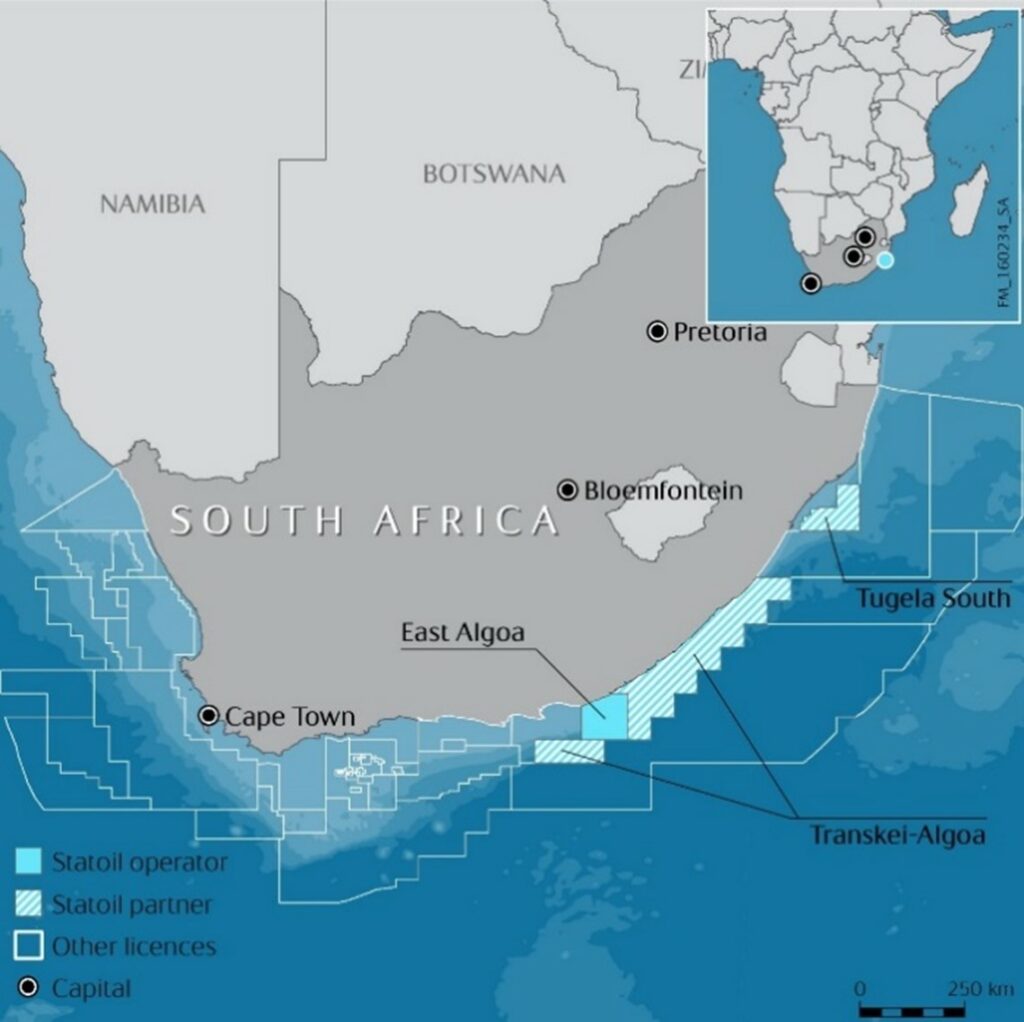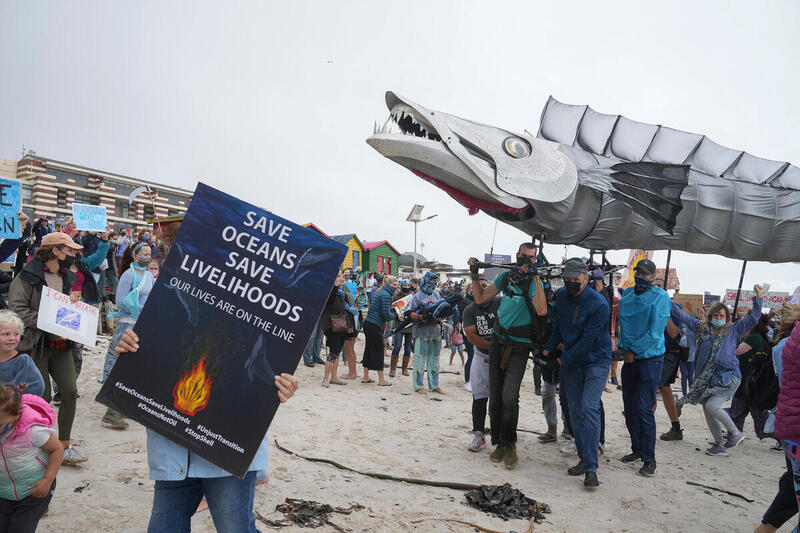Seismic surveying in South Africa

Africa was not terra incognito in a petroleum context. In 2011, oil was produced in 23 of the continent’s countries – mostly in the north, centre and west regions. The four African states in the Organisation of the Petroleum Exporting Countries – Nigeria, Algeria, Angola and Libya – accounted for 85 per cent of Africa’s daily production volume.[REMOVE]Fotnote: https://www.framtiden.no/dokarkiv/rapporter/etikk-og-naeringsliv/678-norsk-utvinningsindustri-i-afrika/file.html. Statoil was engaged in all four, as well as some others.
Statoil in Africa
The company first became involved in African countries with its BP collaboration agreement in 1990. These involved Angola and Nigeria along the west coast. Ghana was entered later. Operations in the continent increased in the 2000s in line with rising demand and prices for petroleum products. During this period, Statoil became involved in the north African states of Libya, Algeria and Egypt. In east Africa, it started exploration activities in Kenya and Mozambique during 2006 and in Tanzania the following year.
Exploration in South Africa
Statoil, America’s Chesapeake Energy and South Africa’s Sasol submitted a joint application for exploration licences covering shale gas in the South African Karoo Basin. Statoil and Chesapeake had already collaborated over shale gas production from the Marcellus formation in Pennsylvania.[REMOVE]Fotnote: DN, 25 November 2009, “Statoil vil ha skifergass i Afrika”. A permit issued in 2010 covered investigations but not drilling.[REMOVE]Fotnote: https://mg.co.za/article/2011-12-01-sasol-puts-karoo-fracking-plans-on-hold/, accessed 19 January 2022. The plans were put on ice the following year.[REMOVE]Fotnote: Ibid.
The first specific mention of South Africa in Statoil’s annual reports was in 2015, when this country was a new area for the company. An involvement there fitted well with its exploration strategy of access on a large scale. Exploring simultaneously in a number of countries gave the company choices about where to develop its long-term international portfolio.[REMOVE]Fotnote: Annual report, 2014, Statoil.
Statoil farmed into South Africa’s Tugela South licence, which was located in a challenging basin “where we believe we can see indications of an active petroleum system with great potential,” said Nick Maden, senior vice president for exploration in the western hemisphere.[REMOVE]Fotnote: DN, 29 October 2015, “Statoil kjøper i Sør-Afrika”.
ExxonMobil, the world’s fourth largest oil company, served as operator. In 2014, it laid plans for a three-year exploration programme to find oil and gas off South Africa.[REMOVE]Fotnote: TU, 25 March 2014, “ExxonMobil med gigantleting utenfor Sør-Afrika”. Statoil farmed in with a 35 per cent stake in 2015, leaving ExxonMobil with 40 per cent. The other partner was Impact Africa with a 25 per cent holding.
Tugela South covered about 9 000 square kilometres off Durban on the east coast, with water depths down to 1 800 metres. Statoil undertook to help acquire 1 000 square kilometres of three-dimensional seismic data as well as geological and geophysical work and reprocessing 2D seismic material. No obligation existed to drill. That would follow in the next phase if the seismic findings provided a basis for that.[REMOVE]Fotnote: DN, 29 October 2015, “Statoil kjøper i Sør-Afrika”.

Despite low oil prices, or perhaps precisely for that reason, Statoil farmed in 2017 into two more new offshore blocks – including one as operator. One of these acquisition followed the same model as two years earlier. Statoil acquired 35 per cent in an exploration licence covering block 12/3/252 Transkei-Algoa. Operator ExxonMobil retained 40 per cent and Impact Africa held the rest. The licence covered about 45 000 square kilometres in waters up to 3 000 metres deep.
Conducted with OK Energy Ltd, the second transaction gave Statoil 90 per cent and operatorship of the exploration licence for 12/3/1257 East Algoa. OK Energy retained 10 per cent. The licence covered some 9 300 square kilometres. Maden still had faith in the potential of the basins off South Africa.[REMOVE]Fotnote: Statoil press release, 7 September 2017, “Statoil adds exploration licences in South Africa”.
Environmental concerns
Although Equinor has not faced protests over its exploration activity in South Africa, other oil companies – including Shell – have experienced opposition. Since 2014, South African online daily Business Report has covered concerns about animal welfare related to petroleum exploration. Noise from seismic surveying can affect whales, fish and other marine life in the area.[REMOVE]Fotnote: https://www.iol.co.za/capeargus/news/increased-pressure-to-stop-shells-seismic-survey-sees-nationwide-beach-protests-0e5b7bbe-de52-4822-bb61-bd6e0ef1538d.
Fears that the local tuna fishing industry would suffer were expressed when ExxonMobil’s seismic survey ship was to tow airguns mounted on a 1.2-kilometre cable and shoot sound waves measuring around 220 decibels at the seabed. The company was therefore recommended to utilise “quiet start” surveying, with meant the airguns began shooting at a low sound level so that fauna had good time to leave the area. The volume could then be increased.[REMOVE]Fotnote: TU, 25 March 2014, “ExxonMobil med gigantleting utenfor Sør-Afrika”.

A number of protests were staged in 2020 against seismic surveying by Shell.[REMOVE]Fotnote: https://www.iol.co.za/capeargus/news/increased-pressure-to-stop-shells-seismic-survey-sees-nationwide-beach-protests-0e5b7bbe-de52-4822-bb61-bd6e0ef1538d. The latter nevertheless secured government permission to start work.[REMOVE]Fotnote: https://www.iol.co.za/news/south-africa/eastern-cape/activists-dismayed-as-shell-wins-seismic-survey-permission-564d74f8-4d9f-4190-a37e-f98d5f6c1606.
New strategy and narrower international commitment
At that point, Equinor was on its way out of South Africa. It withdrew even though Total had made a promising gas/condensate discovery during 2019 in the Brulpadda prospect in an adjacent licence – block 11B/12B.[REMOVE]Fotnote: Total Makes Significant Discovery And Opens A New Petroleum Province Offshore South Africa | TotalEnergies.com, accessed 19 January 2022.
After Anders Opedal took over as Equinor’s CEO in November 2020, the company reoriented its strategy towards making the international portfolio “narrower and deeper”, with involvement in fewer countries. Al Cook was appointed executive vice president for international exploration and production, and led a major review of all the countries where Equinor had a presence.[REMOVE]Fotnote: Al Cook is a British citizen who joined Equinor in 2016 after 20 years in BP. He joined the corporate management team in 2018 when taking over responsibility for strategy from John Knight. The company decided to withdraw not only from South Africa, but also from Australia, Myanmar and the United Arab Emirates. At the same time, a number of divestments were under way, particularly in North, Central and South America. From being present with oil and gas fields in 30 countries in 2017, Equinor sold itself down to around 15 nations by 2020-21. And this clarification and clear-up process marked an end to Equinor’s operations in South Africa.
arrow_backNicaragua – virgin and volatileEldar Sætre – continuity in the companyarrow_forward